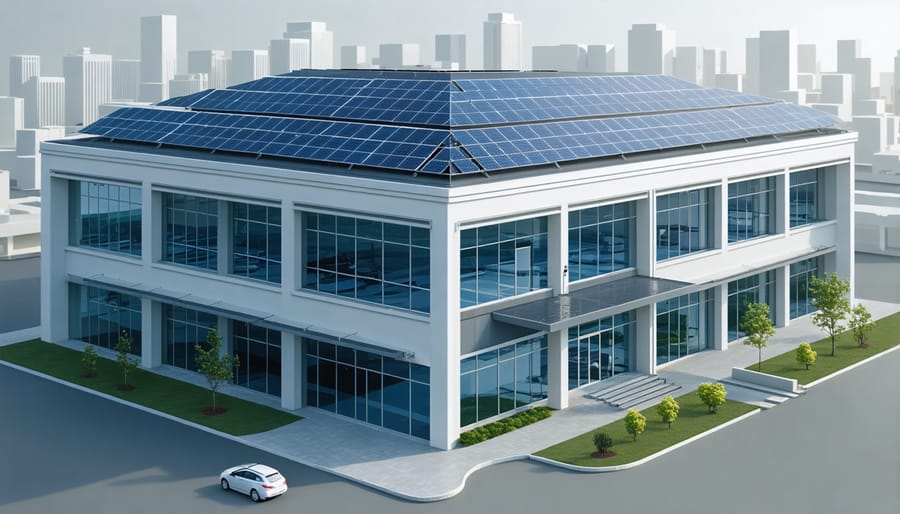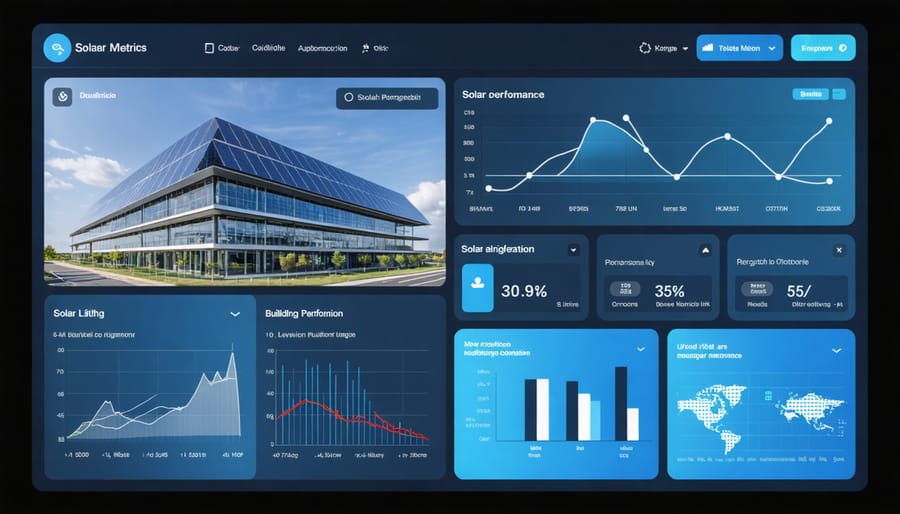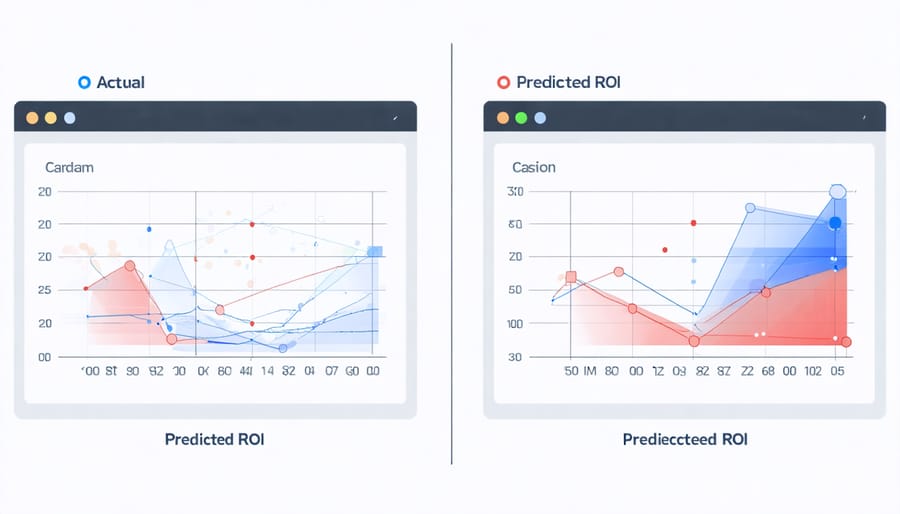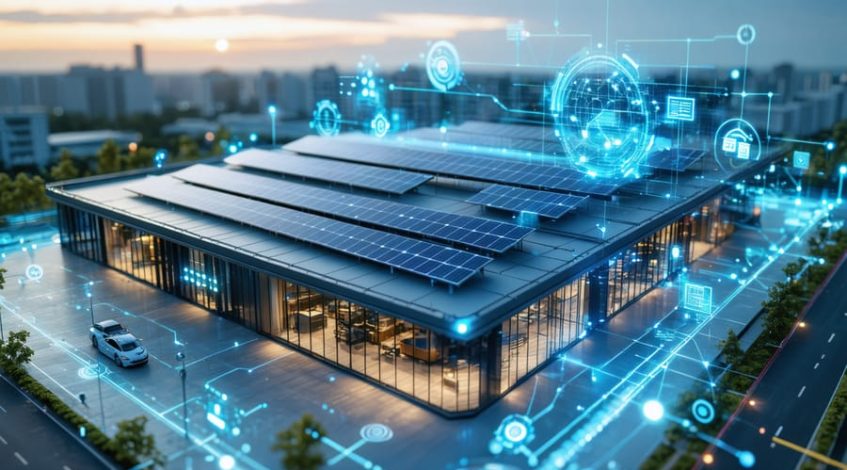Commercial solar design stands at the intersection of sustainable innovation and digital transformation, revolutionizing how businesses harness renewable energy. Advanced modeling software, AI-driven analytics, and smart monitoring systems now enable organizations to maximize their solar investments with unprecedented precision and efficiency. Modern commercial solar installations leverage sophisticated digital tools to optimize panel placement, predict energy production, and automatically adjust systems for peak performance.
The integration of digital technologies has transformed traditional solar design into a data-driven discipline that delivers measurable ROI. Business owners can now access real-time performance metrics, predictive maintenance alerts, and automated energy management systems through cloud-based platforms. These innovations have reduced implementation costs by up to 40% while increasing energy yield by 15-25% compared to conventional designs.
For facility managers and business leaders, contemporary commercial solar design represents more than environmental stewardship – it’s a strategic investment in operational efficiency and long-term cost reduction. With payback periods shortening and technology costs declining, digital solar solutions offer compelling advantages for organizations of all sizes. The combination of advanced design tools, smart monitoring systems, and predictive analytics creates solar installations that actively adapt to changing environmental conditions and energy demands.
Digital Innovation in Commercial Solar Design
3D Modeling and Digital Twin Technology
Modern commercial solar design has been revolutionized by advanced 3D modeling tools and digital twin technology, enabling unprecedented precision in system planning and optimization. These sophisticated platforms create highly accurate virtual representations of facilities, accounting for building architecture, surrounding structures, and environmental factors that influence solar performance.
Using LiDAR scanning and photogrammetry, designers can generate detailed 3D models that precisely map potential installation surfaces, shading patterns, and structural limitations. This technology allows for virtual testing of different panel configurations, helping optimize energy yield while addressing site-specific challenges.
The integration of real-time weather data and performance analytics enables stakeholders to simulate system behavior under various conditions throughout the year. This capability significantly reduces design errors, streamlines the approval process, and provides more accurate ROI projections before installation begins.
For facility managers and business owners, these digital tools offer clear visualization of the proposed solar system, making it easier to understand the project scope and make informed decisions about their renewable energy investments.

AI-Powered Design Optimization
Artificial intelligence is revolutionizing commercial solar design by introducing unprecedented levels of precision and efficiency. Through AI-powered optimization, systems can now automatically adjust panel configurations, predict energy generation patterns, and maximize return on investment.
Machine learning algorithms analyze multiple variables simultaneously, including historical weather patterns, shading analysis, and energy consumption data, to determine optimal panel placement and system sizing. This intelligent approach reduces design time by up to 70% while improving energy yield by 10-15% compared to traditional methods.
Advanced AI tools can simulate thousands of design iterations within minutes, considering factors such as roof geometry, structural limitations, and local regulations. These systems continuously learn from real-world performance data, enabling them to refine their recommendations and adapt to changing conditions.
For facility managers, this translates into more reliable energy production forecasts and better-informed investment decisions. The technology also facilitates rapid design modifications when building requirements change, ensuring solar installations remain optimized throughout their lifecycle.
Smart Integration Solutions
Building Management System Integration
Integration with Building Management Systems (BMS) represents a crucial advancement in commercial solar design, enabling seamless coordination between solar power generation and building operations. Modern BMS platforms can monitor and optimize solar production while adjusting HVAC systems, lighting, and other energy-consuming equipment in real-time.
The integration process typically involves connecting solar inverters and monitoring systems to the building’s central control platform through standard protocols like BACnet or Modbus. This connection allows facility managers to view comprehensive energy data, production metrics, and consumption patterns through a single dashboard.
Smart algorithms within integrated systems can automatically adjust building operations based on solar production forecasts. For example, during peak solar generation hours, the system might pre-cool spaces or schedule energy-intensive tasks to maximize the use of solar power. This intelligent load management can significantly improve overall energy efficiency and reduce utility costs.
Real-world applications demonstrate the effectiveness of BMS integration. A major retail chain implemented this approach across 50 locations, achieving an additional 15% reduction in energy costs beyond standard solar savings through optimized load scheduling and automated demand response participation.
For maximum effectiveness, BMS integration should be considered during the initial solar design phase. This forward-thinking approach ensures compatibility between systems and allows for proper placement of sensors, controls, and communication infrastructure. The result is a more responsive, efficient, and cost-effective commercial solar installation that delivers enhanced value to building operators.
IoT Monitoring and Analytics
In today’s digitally-driven commercial solar installations, IoT monitoring systems have become essential for maximizing system performance and return on investment. These advanced monitoring solutions provide real-time visibility into solar array operations, enabling facility managers to track energy production, system efficiency, and equipment health with unprecedented accuracy.
By leveraging smart sensors and data analytics, businesses can identify performance issues before they impact energy generation. The system continuously monitors key metrics such as panel temperature, power output, and weather conditions, allowing for predictive maintenance and optimal system operation. This proactive approach typically results in 15-20% improved system efficiency compared to traditionally managed installations.
Analytics dashboards provide stakeholders with actionable insights through customizable reports and alerts. Facility managers can access performance data remotely through mobile applications, enabling quick response to any operational anomalies. The integration of machine learning algorithms helps identify patterns and predict potential equipment failures, reducing downtime and maintenance costs.
ROI calculations show that implementing advanced monitoring solutions can pay for itself within 12-18 months through improved energy yield and reduced operational expenses. Many systems also offer automated reporting features for renewable energy certificates and compliance documentation, streamlining administrative processes for business owners.

Cost-Benefit Analysis in the Digital Age
Predictive Analytics for Investment Planning
Modern predictive analytics tools have revolutionized investment planning in commercial solar installations by providing data-driven insights for more accurate financial forecasting. These sophisticated platforms analyze multiple variables, including historical weather patterns, energy consumption trends, and equipment performance metrics, to generate detailed ROI projections.
Advanced simulation software now enables stakeholders to model various installation scenarios and optimize system configurations before breaking ground. These tools consider factors such as shadow analysis, panel degradation rates, and local utility rate structures to predict energy production and cost savings over the system’s lifetime.
Machine learning algorithms enhance these predictions by continuously incorporating real-world performance data, leading to increasingly accurate forecasts. Investors can evaluate different financing options, tax incentives, and depreciation schedules through interactive dashboards that present complex financial data in accessible formats.
For example, a recent manufacturing facility project used predictive analytics to optimize panel placement and sizing, resulting in a 15% higher return than initially projected. The software identified opportunities for peak demand reduction and time-of-use optimization that weren’t apparent in traditional planning methods.
These digital tools also help stakeholders manage risk by simulating various scenarios, including equipment failures, weather events, and market changes, ensuring more resilient investment strategies.

Performance Monitoring and Reporting
Modern commercial solar installations leverage advanced monitoring systems and data analytics to maximize system performance and return on investment. These digital solutions provide real-time visibility into energy production, consumption patterns, and system health through sophisticated sensor networks and cloud-based platforms.
Key performance metrics are continuously tracked, including power output, voltage levels, and environmental conditions. Smart monitoring systems can detect potential issues before they impact performance, enabling predictive maintenance and reducing downtime. Many platforms offer mobile applications that allow facility managers to access system data remotely and receive instant alerts about system anomalies.
Automated reporting features generate detailed analyses of system performance, including energy production trends, financial savings, and environmental impact metrics. These reports help stakeholders demonstrate ROI and comply with regulatory requirements. Advanced analytics tools can benchmark performance against similar installations and identify optimization opportunities.
Integration with building management systems enables comprehensive energy management strategies. Machine learning algorithms analyze historical data to forecast production levels and optimize energy consumption patterns. This data-driven approach ensures that commercial solar installations maintain peak efficiency throughout their operational lifetime while providing transparent documentation of system benefits for stakeholders.
Real-World Implementation
Several noteworthy implementations showcase how digital transformation has revolutionized commercial solar design. The Mall of America’s 2022 solar installation project demonstrates the power of digital twin technology in optimizing panel placement across its massive 5.6-million-square-foot facility. Using advanced 3D modeling and AI-driven simulations, designers achieved a 24% higher energy yield than initially projected, while reducing installation time by approximately 30%.
In California’s Silicon Valley, Google’s Mountain View campus leveraged machine learning algorithms to design its solar canopy system. The AI-powered design process analyzed thousands of potential configurations, considering factors such as shadow patterns, maintenance accessibility, and structural requirements. The resulting installation generates 40% of the facility’s daily energy needs and automatically adjusts panel angles based on real-time weather data.
The Port of Los Angeles provides another compelling example of digitally-transformed solar design. Their smart solar installation combines IoT sensors, predictive analytics, and automated cleaning systems. The system’s digital monitoring platform detected and prevented potential equipment failures, resulting in a 15% increase in system uptime during its first year of operation.
In the retail sector, Target’s nationwide solar initiative exemplifies how digital tools can streamline large-scale deployments. Their standardized digital design approach, incorporating BIM (Building Information Modeling) and automated permitting processes, enabled the successful installation of rooftop solar systems across 500 stores in just 24 months.
Australian mining company Rio Tinto’s solar installation at their Weipa bauxite mine showcases how digital design tools can optimize performance in challenging environments. Using advanced weather modeling and dust accumulation simulations, designers created a system that maintains 92% efficiency despite harsh conditions, saving approximately $2.3 million in annual energy costs.
These implementations demonstrate that digitally-enhanced commercial solar design delivers multiple benefits:
– Reduced planning and installation timeframes
– Improved energy yield through optimized placement and orientation
– Enhanced maintenance efficiency through predictive analytics
– Better ROI through precise performance forecasting
– Increased system reliability and longevity
The success of these projects highlights how digital transformation has become essential in modern commercial solar design, enabling more efficient, profitable, and sustainable energy solutions for businesses of all sizes.
The digital transformation of commercial solar design represents a significant leap forward in how businesses approach renewable energy solutions. By integrating advanced software, AI-driven analytics, and automated design processes, companies can now achieve unprecedented levels of efficiency and ROI in their solar installations. These technological advancements have not only streamlined the design and implementation process but have also enhanced system performance and reliability.
Looking ahead, the future of commercial solar design appears increasingly promising. The continued evolution of digital tools and technologies will further optimize system designs, reduce installation costs, and improve energy generation forecasting. As artificial intelligence and machine learning capabilities advance, we can expect even more sophisticated design solutions that adapt to changing environmental conditions and energy consumption patterns.
For business owners and facility managers, embracing these digital innovations in solar design isn’t just about staying current with technology—it’s about securing a competitive advantage in an increasingly sustainability-focused market. The combination of improved efficiency, reduced costs, and enhanced system performance makes digital transformation in commercial solar design an essential investment for organizations committed to both environmental responsibility and financial success.

